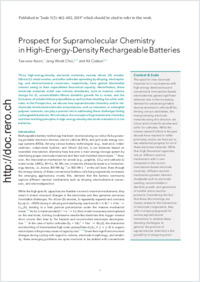Prospect for supramolecular chemistry in high-energy-density rechargeable batteries
- Kwon, Tae-woo Graduate School of Energy, Environment, Water, and Sustainability (EEWS), Korea Advanced Institute of Science and Technology (KAIST), Yuseong-gu, Daejeon, Republic of Korea
- Choi, Jang Wook School of Chemical and Biological Engineering and Institute of Chemical Processes, Seoul National University, Seoul, Republic of Korea
- Coskun, Ali Department of Chemistry, University of Fribourg, Switzerland
-
20.03.2019
Published in:
- Joule. - 2019, vol. 3, no. 3, p. 662–682
English
The quest for new electrode materials for Li-ion batteries with high energy densities beyond conventional intercalation-based electrodes has gained significant attention due to the increasing demand for advanced portable devices and electric vehicles (EVs). Among various candidates, the most promising electrode materials along this direction are silicon and Li metal for anodes and sulfur for cathodes. While the intense research efforts in the past decade have resulted in rather promising results, we have yet to see substantial progress for all of these electrode materials. While their high theoretical capacities rely on different reaction mechanisms with Li ions compared to the current intercalation-based electrode materials, different reaction mechanisms present inherent drawbacks such as electrode swelling, uncontrollable Li dendrite growth, and generation of soluble redox reaction products. Considering the fact that these shortcomings are closely related to the interactions of electrode components, they offer a unique playground for various supramolecular interactions to address these daunting challenges. In general, the promise of supramolecular chemistry is the possibility of designing smart molecules and polymers to carry out complex functions with high selectivity and reversibility by means of molecular recognition. The success of applying such opportunities to the emerging battery systems relies on identifying the right molecular recognition element and supramolecular interactions between the electrode components to make them adaptive, responding to the constantly changing local environment during cycling in the target electrode application; in this Perspective, we shed light on this aspect.
- Faculty
- Faculté des sciences et de médecine
- Department
- Département de Chimie
- Language
-
- English
- Classification
- Chemistry
- License
-
License undefined
- Identifiers
-
- RERO DOC 324647
- DOI 10.1016/j.joule.2019.01.006
- Persistent URL
- https://folia.unifr.ch/unifr/documents/307921
Statistics
Document views: 204
File downloads:
- pdf: 337
